
İskender kebap is a Turkish dish that consists of sliced döner kebab meat topped with hot tomato sauce over pieces of pita bread, and generously slathered with melted special sheep's milk butter and yogurt. It can be prepared from thinly cut grilled lamb or chicken. Tomato sauce and melted butter are generally poured over the dish live at the table, for the customer's amusement.

Turkish cuisine is the cuisine of Turkey and the Turkish diaspora. Although the cuisine took its current rich form after numerous cultural interactions throughout centuries, it should not be confused with other cuisines such as Ottoman cuisine or Seljuk cuisine. Turkish cuisine with traditional Turkic elements such as yogurt, ayran, kaymak, exerts and gains influences to and from Mediterranean, Balkan, Middle Eastern, Central Asian and Eastern European cuisines.

Barbecue or barbeque is a term used with significant regional and national variations to describe various cooking methods that employ live fire and smoke to cook the food. The term is also generally applied to the devices associated with those methods, the broader cuisines that these methods produce, and the meals or gatherings at which this style of food is cooked and served. The cooking methods associated with barbecuing vary significantly but most involve outdoor cooking.

A skewer is a thin metal or wood stick used to hold pieces of food together. The word may sometimes be used as a metonym, to refer to the entire food item served on a skewer, as in "chicken skewers". Skewers are used while grilling or roasting meats and fish, and in other culinary applications.

Gyros, sometimes anglicized as a gyro in some regions, is meat cooked on a vertical rotisserie, then sliced and served wrapped or stuffed in pita bread, along with other ingredients such as tomato, onion, fried potatoes, and tzatziki. In Greece, it is normally made with pork or sometimes with chicken, whilst beef and lamb are also used in other countries.

Kebab, kabob, kebap, or kabab (Kashmir) is roasted meat that originates from the Middle East. Many variants of the category are popular around the world, including the skewered shish kebab and the doner kebab with bread.

Shawarma is a Middle Eastern dish that originated in the Levant region of the Arab world during the Ottoman Empire, consisting of meat that is cut into thin slices, stacked in an inverted cone, and roasted on a slow-turning vertical spit. Traditionally made with lamb or mutton, it may also be made with chicken, turkey, beef, or veal. The surface of the rotisserie meat is routinely shaved off once it cooks and is ready to be served. Shawarma is a popular street food throughout the Arab world and the Greater Middle East.
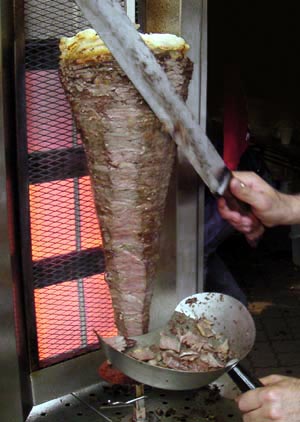
Doner kebab, also spelled as döner kebab, is a dish of Turkish origin made of meat cooked on a vertical rotisserie. Seasoned meat stacked in the shape of an inverted cone is turned slowly on the rotisserie, next to a vertical cooking element. The operator uses a knife to slice thin shavings from the outer layer of the meat as it cooks. The vertical rotisserie was invented in the 19th-century Ottoman Empire, and dishes such as the Arab shawarma, Greek gyros, Canadian donair, and Mexican al pastor are derived from this.
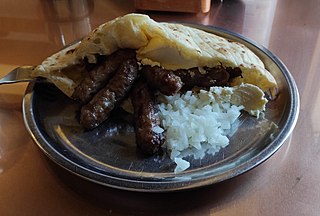
Ćevapi or ćevapčići is a grilled dish of minced meat found traditionally in the countries of southeast Europe. It is considered a national dish of Bosnia and Herzegovina and Serbia, with Bosnia and Herzegovina taking steps in branding and placing them on the list of intangible heritage, with a nomination for inclusion on the UNESCO List of Intangible Cultural Heritage. Ćevapi are also common in Albania, Bulgaria, Croatia, Kosovo, Montenegro, North Macedonia, and Slovenia.
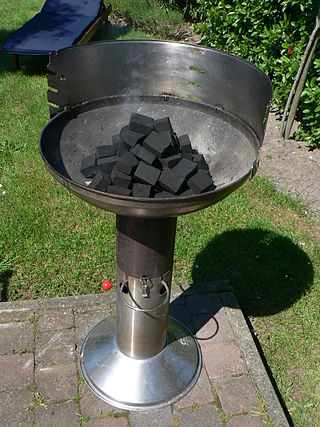
Barbecue varies by the type of meat, sauce, rub, or other flavorings used, the point in barbecuing at which they are added, the role smoke plays, the equipment and fuel used, cooking temperature, and cooking time.

Shish kofta (Turkish) is a type of kebab-style kofta dish in Turkish cuisine.

Shish kebab or shish kebap is a popular meal of skewered and grilled cubes of meat. It can be found in Mediterranean cuisine and is similar to or synonymous with dishes called shashlik and khorovats, found in the Caucasus region.

Beyti is a Turkish dish consisting of ground beef or lamb, grilled on a skewer and served wrapped in lavash and topped with tomato sauce and yogurt.
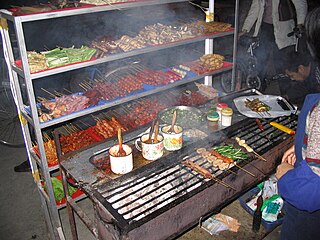
Shaokao, also romanized as shao kao, is the Chinese translation of "barbecue". Chinese variants of the practice constitute a significant aspect of Chinese cuisine. In China, it is predominantly found on busy Chinese streets and night markets as a street food sold in food stalls and is a type of xiaochi. In China and elsewhere, such as in the United States, diners sometimes also order beer as an accompaniment.

Middle Eastern cuisine or West Asian cuisine includes a number of cuisines from the Middle East. Common ingredients include olives and olive oil, pitas, honey, sesame seeds, dates, sumac, chickpeas, mint, rice and parsley, and popular dishes include kebabs, dolmas, falafel, baklava, yogurt, doner kebab, shawarma and mulukhiyah.
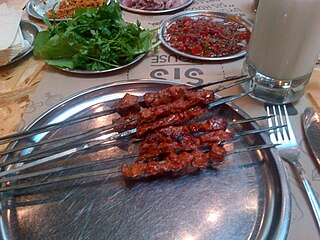
Çöp şiş is a type of lamb shish kebab eaten throughout Anatolia in Turkey.

















